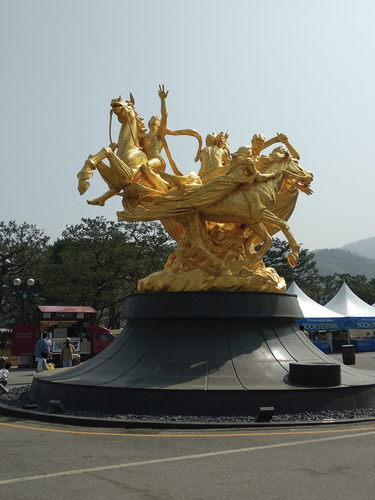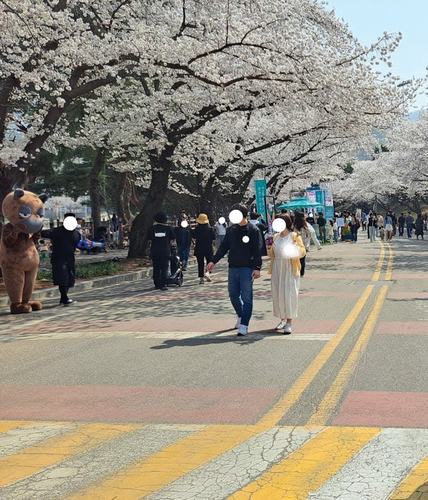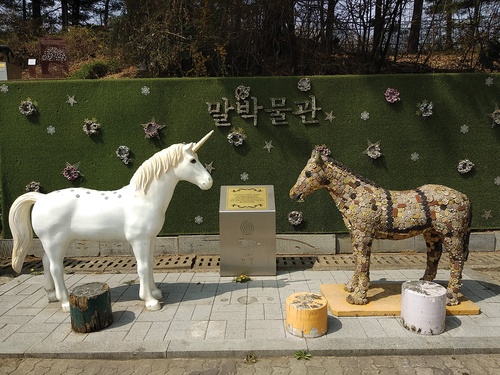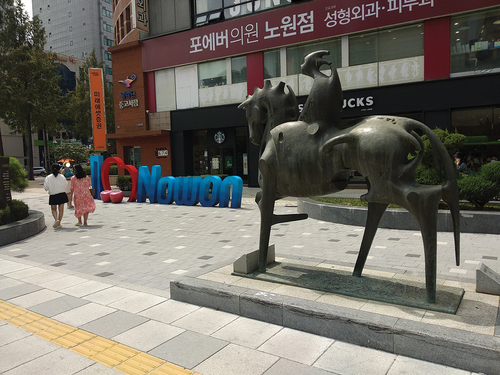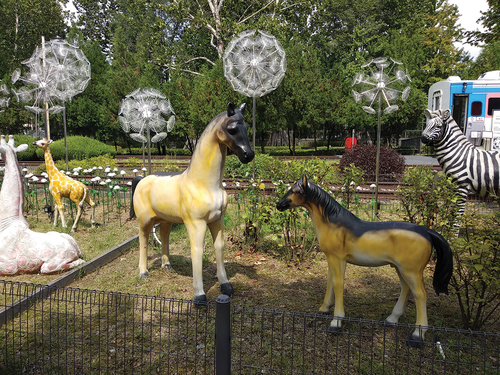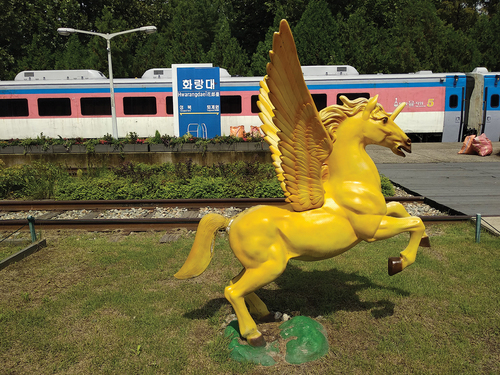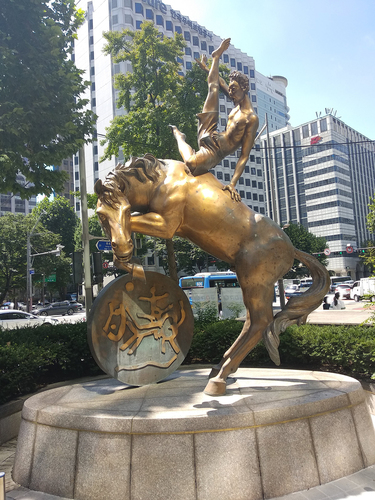ABSTRACT
The horse holds a special place in Korean culture and history. This paper explores how this animal is manifested in Seoul, aiming to reveal the interests and agendas that these manifestations serve, and what this nonhuman presence can tell about contemporary Seoul and South Korea. The paper adds a new perspective to the literature on Seoul’s development and identity formation. It also provides a case study on the interaction between humans and nonhuman-animals. Lastly, it intervenes into cultural landscape theory by offering the concept of ‘collaged cultural landscape’. It is argued that, the multilayered presence of the horse in Seoul represents South Korean aspirations for economic success, positive branding, and post-colonial strength, confidence, and legitimacy, by conveying a wide range of images, including beauty, cuteness, vigor, and valor. Furthermore, there is no other animal in Seoul, and perhaps in all of South Korea, that matches the horse’s complex presence.
Introduction
Seoul is the bustling capital city of South Korea. It is home to approximately 9.7 million residents, and including the wider metropolitan area (Seoul Capital Area), the population exceeds 26 million. It is a hyper-modern center of politics, culture, and consumerism, yet this megacity also engages with nature in several ways. For instance, it was built according to the principles of Chinese geomancy, surrounded by mountains, and the Han River, which used to mark the southern natural boundary, now flows across the modern city. Seoul also offers plenty of mountain trails that attract numerous hikers on the weekends. Over the years Seoul Government has made substantial investments in green spaces (see Seoul Metropolitan Government Citation2023), including Seoul Forest, Seoul Botanic Park, and the restoration of the Ch’ŏnggye Stream (Ch’ŏnggyech’ŏn) which stretches nearly 6 km in length and became a city landmark.Footnote1
Regarding noticeable animals, there has been a surge in the popularity of (controversial) animal cafes in the country, with dozens of such establishments in the Seoul area alone. In these cafes patrons can interact with a variety of animals, including dogs, cats, raccoons, meerkats, sheep, and more. Additionally, while historically the attitude towards dogs in Korean society has been ambiguous (Dugnoille Citation2018), research suggests that the trend of dog ownership, or dogs as companions, is clearly on the rise in the country (W.-H. Kim et al. Citation2020). Indeed, in the past decade or so I have noticed the growing number of people walking with their pet dogs on the streets of Seoul, the disappearance of cages displaying dogs for consumption in the markets, and protests against the consumption of dog meat that occasionally take place at Gwanghwamun Plaza in the city center. Finally, the tiger is a culturally significant animal in Korea which, in modern times, has manifested as a cultural symbol on various occasions in South Korea (see H. Kim, Clements, and Rhyu Citation2023; Seeley and Skabelund Citation2015). In Seoul’s landscape tiger statues are found at locations like Inwangsan Mountain, Seoul Grand Park Zoo, and Korea University. Obviously, in comparison to the other animals mentioned, the tiger can only be seen from a distance at the zoo or experienced symbolically, rather than being physically touched and interacted with.
Against this background of human-nature encounters in Seoul, another observable more-than-human presence in the city is the horse, an animal which holds a special place in Korean history and culture. How is the horse manifested in Seoul’s landscape? What interests and agendas do these manifestations serve? What can this nonhuman presence tell about contemporary Seoul and South Korea? To explore these questions, I adopt the conceptual framework of ‘cultural landscapes’ and introduce the term ‘collaged cultural landscape’.
The paper makes three main contributions. First, at the intersection of Korean studies and urban studies, scholars have explored the multi-dimensional aspects of Seoul’s development and identity formation. Within this body of literature, studies investigated the interplay between history, culture, and environment (e.g. Chung Citation2005; Han and Cho Citation2010; Jeon and Kang Citation2019; M.-J. Lee Citation2019). The paper adds a new perspective to this scholarship. Second, especially since the turn of the 21st century, academic interest in interactions between humans and nonhuman animals has been expanding. Scholars have particularly advanced a relational approach, arguing that nonhuman animals should be viewed as constituting part of political life and political space (Hobson Citation2007) and of an interspecies culture (Sanders Citation2003). The paper’s case study enriches this literature. Finally, by offering the concept of ‘collaged cultural landscape’, I wish to make an intervention into cultural landscape theory.
The following section provides the theoretical framework for the discussion. Next, I present a brief survey of the horse’s place in Korean culture in order to establish the paper’s thematic background. It is then followed by three sections, each dedicated to a distinct aspect of the horse’s manifestation in Seoul: the horse in leisure, sport, and entertainment, the horse as a symbolic device, and, lastly, Seoul’s horse-themed district.
The collaged cultural landscape
The term ‘cultural landscapes’ has garnered increasing interest and attention from scholars and practitioners in the 1990s (Taylor Citation2012). In 1992 UNESCO’s World Heritage Convention became the first international device that recognized and protected legally ‘cultural landscapes’. The idea was that,
cultural landscapes represent the ‘combined works of nature and of man’ … They are illustrative of the evolution of human society and settlement over time, under the influence of the physical constraints and/or opportunities presented by their natural environment and of successive social, economic and cultural forces, both external and internal. (UNSECO Citationn.d.)
The Cultural Landscapes Foundation TCLF (Citationn.d.) further elaborates on this fundamental understanding of the term by stating that ‘cultural landscapes are works of art, narratives of culture, and expressions of regional identity’. Most importantly, cultural landscapes are meaningful because ‘they are a legacy for everyone’. According to TCLF (Citationn.d.), ‘these special sites reveal aspects of our country’s origins and development as well as our evolving relationships with the natural world. They provide scenic, economic, ecological, social, recreational, and educational opportunities helping communities to better understand themselves’. Accordingly, cultural landscapes can include ‘thousands of acres or a tiny homestead’, an industrial site, a park, garden, cemetery, campus, plantation, battlefield, monument, district, etc (TCLF Citationn.d.). Thus, scholarship of cultural landscapes pointed to two interrelated essential aspects. First, landscape is both a visual product – i.e. ‘what we see’ – and the sense it creates and how it is interpreted – i.e. ‘a way of seeing’ (Zhang and Taylor Citation2020, 165). Second, landscape is a dynamic process susceptible to change and transformation (Zhang and Brown Citation2023; Zhang and Taylor Citation2020), meaning, it ‘tell[s] the story of people, events and places through time, offering a sense of community: a sense of the stream of time’ (Taylor Citation2012, 31).
Succinctly put, a cultural landscape refers to an environment that acquires cultural meaning and significance through human involvement. This involvement includes social, economic, and political interactions of stakeholders and the public which shape and reshape the landscape. By critically investigating the cultural landscape we can gain insights into the respective society, revealing the associated interests, agendas, power balances, and existing conflicts. Thus understood, the term ‘cultural landscape’ is not just a rigid analytic tool but a flexible conceptual framework.
What happens, though, when the research direction is not of a single, specific cultural landscape, but, instead, of multiple cultural landscapes associated with a single cultural product? In this regard I offer the notion of the ‘collaged cultural landscape’. A collaged cultural landscape is an object, figure, or practice that visually and conceptually materializes in various forms across different locations within an environment such as a town, city, or country. This occurs through the activity of a single agency or different stakeholders who are not necessarily connected to each other. Accordingly, the collaged cultural landscape can be construed as the tangible manifestation of the cultural policies behind it. An assemblage of local cultural landscapes, the idea of the collaged cultural landscape thus widens the lens and presents an opportunity for a more comprehensive understanding of the broader host environment. Seen in this light, if the city of Seoul is a complex, multi-layered, multi-faceted, and dynamic cultural landscape, the horse constitutes a collaged cultural landscape – a ‘sub-cultural landscape’ so to speak – under its roof. Thus the horse is not only ‘in the cultural landscape’ but also ‘as a cultural landscape’.
The horse in Korean history and culture
Horses have occupied a special place in different human cultures across time. There have been multiple uses for the animal, and as Coulter (Citation2014, 135) puts it, ‘horses have been valorized, loved, worked, exploited, and slaughtered’. On the Korean peninsula too the importance of horses dates back thousands of years. Scholars (Ok, Choi, and Jeong Citation2010) suggest that the existence of cavalry soldiers can be traced to Kojosŏn (2333–108 BCE) which is considered ‘the first Korean kingdom/state’. Later, during the Three Kingdoms period, which was dominated by Koguryŏ (37 BCE-668 CE), Paekche (18 BCE-660 CE), and Silla (57 BCE-935 CE), the cavalry was also the main force of the Koguryŏ army. It is important to mention in this context that Koguryŏ is remembered as a mighty and powerful kingdom of warriors. No other Korean entity has ever ruled over a territory larger than Koguryŏ at its peak. In addition, it managed to defeat massive invading Chinese forces. Between 598 and 614 Koguryŏ successfully repelled a series of attacks by the Sui dynasty, and in 645–648 it emerged victorious against the invading army of the Tang dynasty. Thus, as Jang and Kim (Citation2023) explain, Koguryŏ’s cavalry was divided into light cavalry and heavily iron armored cavalry, with the cooperation between the two groups being a key factor in the kingdom’s victories on the battlefield. Additionally, mural paintings from Koguryŏ depict mounted warriors hunting wild animals, and, according to ancient accounts (Ok, Choi, and Jeong Citation2010) horseback archery was promoted in Paekche as well. Finally, relics that were excavated suggest that the horse also played a significant role in the Kaya confederacy (42–532[562]), a fourth kingdom that existed at that time on the peninsula (Museum News Citation2020).
The horse was important in several aspects for Silla, which completed the conquest of the other kingdoms in 668 CE and ruled over most of the peninsula until 995 CE. First, the kingdom implemented a system of paved roads, recognizing the importance of horses as a means of transportation (KRA Citationn.d.-c). Second, during the Silla dynasty a military elite known as the hwarang (literary, ‘flower of youth’) was created. Horsemanship, along with martial sports like archery and swordsmanship, formed the foundation of the hwarang’s training (Ha and Mangan Citation1998). Third, archaeological excavations have uncovered ceramic vessels shaped like horse riders dating back to the early 6th century. These vessels were likely used by Silla royalty to serve liquids, and their discovery in tombs suggests a belief that horses guided the deceased to the afterlife (National Museum of Korea Citation2019).
Against the backdrop of Silla’s decline, rebellious forces emerged, and the early 10th century was a period of turmoil and instability. These decades of unrest came to an end when the state of Koryŏ (918–1392) successfully reunified the peninsula in 936. According to Kim Myŏng-jin (Citation2016), a skillful utilization of cavalry played a pivotal role in this process.
During the Koryŏ dynasty, the royalty and nobility possessed impressive horsemanship and horseback hunting skills, and the horse commonly featured in paintings and myths (Kallander Citation2023). Furthermore, in the 13th century the dynasty faced one of the most formidable fighting forces in history: the Mongols. The Mongols, who established the Yuan dynasty in China (1271–1368), launched a series of attacks that led to their domination over Koryŏ until the mid-14th century. With the horse and mounted warfare being integral to their culture, the Mongols identified the southern island of Jeju as an ideal location for horse breeding. Consequently, they brought horses from Mongolia and crossbred them with local horses. They also introduced horse-breeding techniques and built military horse ranches on the island (Editor Citation2018; H. Kang Citation2022; S.-H. Lee Citation2013). Overall, the horse held such great value that, according to a document from the late 14th century, it was exchanged for two or three slaves (S-E. T. Kim Citation2016, 14).
During the Chosŏn dynasty (1392–1910), as Kallander argues (Citation2023, 120), the horse was ‘the most significant domesticated animal’. Texts from that period shed light on the various uses of horses in farming. Horses were utilized to plow fields, transport crops, and turn the millstone, and their manure was used as fertilizer. Different parts of the horse were utilized as well: horsehair for making headbands and caps, horsehide for crafting items such as musical instruments, horse bones for medical purposes, and horse meat and milk for consumption. The horse’s role as a means of transportation remained significant as well (KRA Citationn.d.-c). Regarding warfare, in the late 16th century Japan launched massive invading forces into Korea, resulting in significant damage to the Chosŏn dynasty. The Chinese sent troops to aid the Koreans, and all three armies involved in the conflict employed cavalry (Swope Citation2005).
Besides its utilitarian function, the horse has been deeply ingrained in Korean belief systems and the arts throughout history. As mentioned, the horse was seen as a conduit that connected our world with the netherworld. Historical records from the 12th and 13th centuries also mention horses as sacred animals and as part of auspicious signs. Additionally, the horse was at the center of various ceremonial rites including those held to commemorate the horse god. Throughout different periods the horse has appeared in novels, poems, folk songs, paintings, proverbs, and folk games and entertainment such as traditional polo (National Folk Museum of Korea Citationn.d.).
Given the flow of people, goods, and ideas in East Asia throughout history, a few brief comparative references would be useful in contextualizing the distinctiveness of Korean horse culture. To start with, the place most associated with the horse in the region is Mongolia. According to Myadar (Citation2011), the modern Mongolian state has established the horse as the national emblem representing the essence of Mongolian identity through a process of romanticizing the past. As the animal has historically been an inseparable part of the lives of the people in that area, the arrival of Mongol horses has impacted not only breeds in Korea, but also in China (Li Citation2019) and Japan (Tozaki et al. Citation2019). Yet compared to the evidence of the consistent and substantial utilitarian use and cultural and religious value of horses in China (Li Citation2019; Shahar Citation2019) and Korea since ancient times, scholars (Tozaki et al. Citation2019, 449) point out that in Japan horses were used in warfare by Samurai warriors between the 12th and the 17th centuries. Later they were used for transportation and agriculture too (Tozaki et al. Citation2019, 449). In any case, the tradition of local horseback archery has been preserved in all four modern states mentioned. Additionally, horseracing too exists in all four countries, though Mongolia has its unique type in this regard. While betting on races is illegal in Mongolia and China, it is allowed in China’s special administrative region of Hong Kong, where it is a big business just as it is in South Korea and Japan as well. Finally, in North Korea the horse has been utilized to serve the regime’s interests. There is evidence of investments in horse-riding facilities and celebratory equestrian events, and the white horse has been adopted as a symbol of power and legitimacy of the ruling Kim family (KBS World Citation2023).
Seen against this background, the rich historical and cultural heritage of the horse in warfare, economics, martial arts, arts, customs, and religion has left several noticeable imprints in contemporary South Korean society.Footnote2 First, the hwarang have become a well-known icon in South Korea, commemorated and employed in various social and cultural contexts. In addition, the Koguryŏ murals of the mounted archers are a familiar object as well. Second, in Jeju, which is a highly popular tourist destination and home to over fifty percent of the approximately 27,000 horses living in South Korea (Editor Citation2018), horse riding has become a major attraction. The native Jeju horse, which is a crossbreed between indigenous and Mongol horses, was designated as a Natural Monument by the government in 1986, and the island hosts the annual Jeju Horse Festival. Third, horseracing is immensely popular in the country, as discussed later in the paper. Fourth, since the mid-2000s there has been a growing interest in both horseback riding and horseback riding for rehabilitation and treatment (J.-M. Kim Citation2017). Approximately one million people have experienced horseback riding (C.-Y. Park Citation2022), with nearly 60,000 engaging in regular horse riding (Statista, Citation2023). Fifth, a few universities in the country have a Department of Horse Industry. Sixth, although it is a relatively niche martial art, horseback archery is still being practiced. Finally, as the rest of the paper discusses, the horse has become a collaged cultural landscape in Seoul.
Let’s Run Park Seoul: horseracing and more
The establishment of horseracing on the peninsula occurred during Japanese colonial rule (1910–1945). The first authorized Korean horseracing club was founded in 1922, and the sport was further systemized during this period. Initially, horseracing took place at a venue located in the Dongdaemun District of the capital city (see in ). After liberation, South Korea’s Korea Racing Association (today, Korea Racing Authority) was founded in 1949, and the construction of a new racecourse was completed in Ttuksŏm, Seoul, in 1954. The popularity of horseracing increased in the 1980s when the betting system on the sport was computerized and horseracing became televised in color. In the middle of that decade the Olympic Equestrian Park was constructed in Kwach’ŏn on the southern outskirts of Seoul for the 1988 Summer Olympic Games. In 1989 it became the Seoul Racecourse, replacing the venue in Ttuksŏm. The country’s two other current racecourses opened in Jeju and in Pusan, South Korea’s second largest city, in 1990 and 2005, respectively (KRA Citationn.d.-b).
Figure 1. Seoul’s districts (Source: Ralf. Wikimedia Commons, https://en.wikipedia.org/wiki/File:Map_Seoul_districts_de.png).
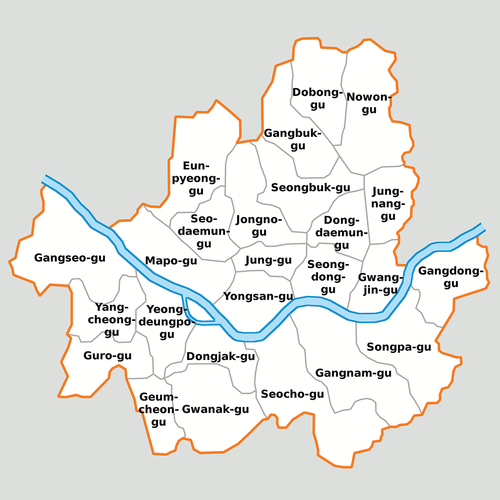
With approximately 16,000 people involved in South Korea’s horse industry, its economic scale is continuously expanding (J.-Y. Kim Citation2015; C.-Y. Park Citation2022). Specifically, horseracing thrives as a business and a popular leisure activity. The country’s three racecourses host approximately 2,750 races each year, and they have reportedly attracted nearly 16 million attendees from a population of about 51.7 million. Out of South Korea’s 1,024 racehorse owners, 107 trainers, and 128 jockeys, 492, 54, and 57 are registered in Seoul, respectively (KRA Citationn.d.-d).
Regarding gambling, betting on horses is only legal through on- and off-course terminals operated by the Korea Racing Authority (KRA), which is a public company under the Ministry of Agriculture, Food, and Rural Affairs. In May 2023 the National Assembly passed an amendment to the Korea Racing Authority Act allowing the KRA to also sell betting tickets online. Horse gambling is a highly profitable business for the KRA: in 2019 the annual racing turnover reached 7.3 trillion Korean won (approximately 6.3 billion US dollars), and after it had dropped to 1 trillion Korean won in the COVID years of 2020–2021, it rebounded to pre-pandemic level in 2022. This places South Korea among the top seven countries in the world in terms of total turnover (Morgan Citation2022).
The largest horseracing compound in the country is Let’s Run Park Seoul (Retch’ŭrŏn P’ak’ŭ Sŏul; commonly written as Let’sRun Park Seoul). Formerly known as the aforementioned Seoul Racecourse, the compound is located, as mentioned, in Kwach’ŏn in the Seoul Capital Area. Bordering Seoul’s southern Gwanak District and Seocho District, Kwach’ŏn is a small city with a population of approximately 80,000 and is home to other famous attractions associated with the capital city, such as the Seoul Grand Park complex. According to the website of Kwach’ŏn City (Citationn.d.), the horse is one of the four ‘natural symbols’ designated by the city, representing its vision of ‘strength’, ‘dynamism’, and ‘new leap toward the future’.
Let’s Run Park Seoul covers an area of nearly 1,150,000 square-meters. The track can accommodate a total of 77,000 spectators in two grandstands, and the facility’s stable area can house approximately 1,400 horses. In addition to the racetrack and stables, other main attractions on the premises include a family park, horse riding experience, and the Equine Museum.
Horseraces are held on Saturdays and Sundays, and besides a large parking lot, the site is conveniently accessible from Seoul Racecourse Park (Kyŏngma Kongwŏn) station on subway line number 4. The station itself sets the proper atmosphere with colorful paintings of horses, and there are also booths selling horseracing magazines. From the station’s exit it’s a short walk through a mostly covered path that leads to the compound.
The place has mainly been aimed at the local public: during my last visit on April 2023, there were still no signs in languages other than Korean at the ticket office at the entrance. Once past the entry gates, the visitor notices that the grounds outside the dominating structure of the racetrack’s grandstands are peppered with horse sculptures of various types (). Additionally, there is an outdoor oval arena in front of the building, equipped with stands where visitors can sit and observe the racing horses. Outdoor screens are also available for people to watch the races live and check the outcome of their bets.
The fact that the place is a prominent gambling venue has been the most significant factor influencing its current desired image and physical features. As Kang and Park (Citation2016) convincingly argued, the KRA was motivated to transform the way horseracing was perceived in South Korean society due to its negative association with gambling. Therefore, since the late 1990s the Association implemented several changes including renaming the venue to ‘Let’s Run Park’ – thus dropping ‘horseracing’ from the title – and rebranding the place through initiatives such as creating spaces that catered to the entire family, and hosting various cultural events and festivals. This effort served as a ‘legitimization strategy’ aimed at constructing a positive image of horseracing as a leisure activity (S. H. Kang and Park Citation2016). In the rank-oriented South Korean society, this also has a broader implication. In 2022, at a ceremony commemorating the 100th anniversary of Korean horseracing, CEO Chŏng Ki-hwan announced the Association’s new vision: to position South Korea among the top five countries in the horse industry by the year 2037. Chŏng stated that by this, ‘we will make K-Racing [Korean racing] proud in the world by embodying values beyond horse racing as an industry that contributes to the nation and the public interest’ (K. Lee Citation2022).
The family park at Let’s run Park Seoul includes areas for recreation and picnics, Pony Land for children, a horse riding experience, gardens and ponds, racing simulation machines, ice rinks during the winter, and a water festival during the summer. There are a couple of easy walking trails that connect visitors with nature, and several restaurants and a row of stalls selling food, snacks, books, bags, socks, etc. are also available for them to enjoy. Throughout the year the compound hosts events such as Halloween festivals, Children’s Day events, parades, running events, and, thanks to a road lined with cherry trees, a cherry blossom festival (). Thus, the KRA has been promoting the place as an ideal spot for families and couples. For example, it recommends different waking courses in the compound for categories such as ‘family’, ‘friends’, and ‘lovers’ (KRA Citationn.d.-a). Other media channels have also echoed this image, portraying the place as a popular destination for families and couples to go on a date (e.g. S.-P. Kang Citation2022; S.-W. Lee Citation2017). Reportedly, it is attended by 50,000 to 60,000 visitors per week (P.-C. Kang Citation2023). Based on observations I made there on several weekends during the spring of 2023, when races were being held, it is evident that the crowd consists of a considerable number of families and young people. Therefore, the place provides the type of entertainment that is apparently in demand, and its desired image has evidently caught on.
In addition to betting and leisure activities, Let’s Run Park Seoul offers an educational experience through the Equine Museum (Mal Pangmulgwan), which was first of its kind in the country. The museum opened in 1988, and it became a member of the International Council of Museums (ICOM) in 1997. According to the KRA, its aim is to ‘restore and disseminate the disappearing horse culture’ (KRA Citationn.d.-e). Located at an inconspicuous corner across from the racetrack and past the outdoor oval arena, the modest museum is housed in a one-story building with an exhibition space of 407 square-meters. In front of the museum there is a small lot of colorful flowers, and next to it models of two horses facing each other. The adjoining sign explains that these are the Unicorn called ‘A1’ and the ‘cookie horse’ named ‘K’ik’i’ (). The text invites the visitor to touch the horn of A1 and stroke the neck of K’ik’i because it may bring good luck. ‘Climb on the backs of cute A1 and K’ik’i’, the text continues, ‘and make a wish while taking pretty pictures’. This dose of cuteness is administered to the visitor before they enter the museum as part of the friendly and welcoming image that the compound is designed to create.
Admission to the museum is free, and there are photographs on the outer wall displaying the history of the Korean Grand Prix. Inside, one room showcases changing exhibitions while the second houses the permanent exhibition. On display are items from the pre-Three Kingdoms’ period to the modern era, such as horse bits, horse trappings, horse bells, harnesses, decorations, stirrups, horseshoes, whips, saddles, and horse-rider shaped vessels. Additionally, the exhibition features horseracing artifacts such as a model of the first Korean racetrack, equipment and figurines of notable South Korean jockeys, and golden horseshoes that honor local star racehorses. Alongside plenty of explanatory texts, animations, and horse models, the exhibition covers the various aspects of horses in Korean history and culture. Regarding the target audience, there are English-language translations available, although they only provide basic information for the foreign visitor. Finally, though the museum is unique and informative, it does not draw the same amount of attention as the other attractions that Let’s Run Park Seoul has to offer. During my visits to the compound, the pattern I noticed was that the racetrack and the area with family facilities, food stalls, and walking trails were bustling with activity, while occasionally just a handful of visitors would stroll around the museum’s vicinity and attend it.
Overall, Let’s Run Park Seoul offers an interaction between humans and a nonhuman animal. Two prominent interconnected features of human-horse relations come into play in this regard. As Hausberger et al. (Citation2008, 3) point out, the diverse uses of the horse are related to the diversity of people involved, and, these encounters range on a spectrum from short sporadic interactions to long-term connections. Accordingly, Let’s Run Park Seoul brings together both occasional visitors, some of whom watch the races or engage in recreational horseback riding, and professionals from the industry such as riders, caretakers, veterinarians, etc.
Yet, in fact the park provides an experience that goes beyond this, making the site a major component in the horse’s collaged cultural landscape. The cultural landscape of the place was formed as different cultural strategies accumulated in response to changing needs and interests. Originally the manifestation of a cultural policy focused on a sports-related industry and a lucrative gambling business, the site further evolved with the introduction of the new vision in the late 1990s of re-branding the place as a family-friendly spot of leisure. Common to both policies was a third strategy implemented primarily through the museum: advancing horse-culture and arousing national sentiment. Through this site the horse has thus become a tool that merges, represents, and addresses fundamental desires in contemporary South Korea, including economic strength, positive image/branding, and national pride. Indeed, if horse history is to hold a significant place with regards to the latter, more needs to be done there given the current situation of the Equine Museum. Nevertheless, connections between the horse and sentiments of pride and belonging are formed in Seoul through more components of said collaged cultural landscape, namely statues scattered throughout the city. These connections are discussed below.
Horse statues: the horse as a symbolic device
Art historian Pia F. Cuneo (Citation2012, 88) has aptly stated that, ‘equestrian iconography, going back to antiquity, sent a clear, unmistakable signal about the wealth, power and prestige of a man on horseback’. This is true for the symbol of mounted men and gods across different cultures around the world (see, e.g. Birke and Brandt Citation2009; Shahar Citation2019; Stewart Citation2012), and, as Birke and Brandt (Citation2009, 195) stressed, ‘the combined embodiment of horse and rider resonates with masculinity’. This type of horse symbolism has contributed to the formation processes of South Korea’s post-colonial national identity.
National identity is a sense formed by a group of people who invoke a ‘belief in a shared culture, history, tradition, symbols, kinship, language, religion, territory, founding moment, and destiny’ (Guibernau Citation2004, 134). In this context, heritage is the practice and process of making identity through activities such as remembering, commemorating, and expressing values and meanings (Smith Citation2006, 83). It is the process through which ‘a society becomes visible to itself and to others’ (Assmann Citation1995, 133).
In South Korea, two major influences on the formation of national history and post-colonial identity have been the period of Japanese colonial rule and the presence of a sister-rival to the north. The experience of colonial subjugation and humiliation has inspired a post-colonial narrative of heroic resistance and resilience, formed to also establish and strengthen South Korea’s stance and superiority in the face of the legitimacy battle with North Korea. Accordingly, the notion of continuity and a direct link from pre-divided Korea to the post-colonial Southern state and government is fundamental to the national history.
The systematic institutionalization of cultural heritage in the country first took place under the nation-building project of the dictator Park Chung-hee (1961–1979). Reinforcing the link that was made between martial manhood and the nation-state under Japanese colonial rule, President Park sought to revive the nation’s ancient martial spirit while adjusting it to his interests and agenda (Jager Citation2002). Park promoted a historical narrative that would legitimize his regime, and, against the background of the rivalry with North Korea, would send the message of defeating communism (Chŏng Citation2007; Jager Citation2002). Park was a former army general who had taken over the country via a military coup. Accordingly, his selective cultural practices focused on military heroes, martyrs, and mythical founders to instill and advance ideals of patriotism, loyalty, and sacrifice (Chŏn Citation2012; Sintionean Citation2014). Against this background, in the 1960s Park’s government initiated a project to erect statues of national heroes throughout the country (see Chŏng Citation2007). One of the most notable and dominating statues was built in the heart of Seoul in 1968, depicting Admiral Yi Sun-sin. Admiral Yi (1545–1598), who fought against the invading Japanese forces in the late 16th century, arguably became South Korea’s most celebrated historical figure.
Park’s commemorative project included several bronze equestrian statues, the first of which was built in 1966. The statue was dedicated to General Kyebaek of Paekche, who led his troops in 660 CE against a much larger invading joint Silla-Chinese force. Eventually he lost the battle and was killed, and Silla destroyed Paekche. However, the story of his bravery was revived. Kyebaek is considered a symbol of Puyŏ County, which now occupies the area where Paekche used to be, and his statue was built in the county’s city of Nonsan, located approximately 150 km south of Seoul.
Other equestrian statues too were built outside the capital city during the Park era. In 1971 such a statue was erected for Koryŏ official and commander Kang Kam-ch’an (948–1031) in Suwon, which is about 30 km south of Seoul and considered part of the Seoul Capital Area. In 1972 an equestrian statue was built for Chosŏn military general Kwak Chae-u (1552–1617) in Daegu, approximately 240 km south-east of Seoul. Finally, in 1977 a statue portraying Silla official and military general Kim Yu-sin (595–673) riding a horse was constructed in Gyeongju, located about 280 km south-east of Seoul.
Turning now to Seoul, an equestrian statue was built for the aforementioned Kim Yu-sin in 1969. Kim is considered to have played a critical role, both as a politician and a military commander, in the unification of the peninsula under Silla. Accordingly, through statues of figures such as Kim and Admiral Yi Sun-sin, Park Chung-hee would form a military-oriented historical bond, intended to define and legitimize the importance of his own place in Korean history.
Depicting Kim in military armor, charging on his horse while pointing his sword forward, the statue’s location holds significant meaning. Originally constructed in front of City Hall, the statue was moved in 1971 to Namsan Park in Jung District (see in ). Situated at the center of Seoul, Namsan is a 270 m-high-mountain that overlooks the city. During the colonial period, the Japanese built the colony’s most important Shinto shrine there. The large complex, which was dedicated to the Japanese indigenous religion, held a dominant presence in Seoul (known as Keijō at the time) and served as a symbol of colonial domination and Korean humiliation until it was destroyed after the colonial rule had ended. As part of the systemization of national history during the Park era, a series of statues were erected at Namsan to honor historical figures from different periods. The remodeling of this meaningful landscape, which included Kim Yu-sin’s statue, was symbolically significant as it represented the triumph over the painful memory of colonialism.
Decades after Park’s dictatorship, more equestrian statues depicting heroic military men have emerged throughout South Korea. Examples include the statue of Koryŏ general Lee Pang-sil (1298–1362) in Ham’an-gun, built in 2002; an additional equestrian statue for Kyebaek in Nonsan, constructed in 2012; the statue of Koguryŏ general Ǔlji Mundŏk, completed in Inje in 2016; the statue of Chosŏn general Kwŏn Yul (1537–1599), erected in Ulsan in 2017; and the statue of Chosŏn general Chŏng Ki-ryong (1562–1622), built in Sangju in 2022.
In Seoul, a second equestrian statue of the aforementioned Koryŏ official and commander Kang Kam-ch’an was erected in 1997 at Kan’gs birthplace: Gwanak District at the southern part of the city (see in ). Located in Naksŏngdae Park, which was built in the early 1970s to honor Kang, the statue depicts the General mounted on a horse and holding a sword (). Finally, statues of the hwarang, the military elite of the Silla dynasty, complete the equestrian-based heroic landscape of statues in Seoul. These statues were erected in 2016 to commemorate the 70th anniversary of the establishment of the Korea Military Academy. One statue, depicting a mounted hwarang wielding his spear, is located inside the academy. The second statue portrays a horseback hwarang shooting an arrow and is placed in front of the main gate (). These statues can be found in Nowŏn District, which will be discussed in the next section.
Figure 7. Hwarang equestrian statue in front of the Korea Military Academy, Nowŏn District (Photograph by Author, 2023).
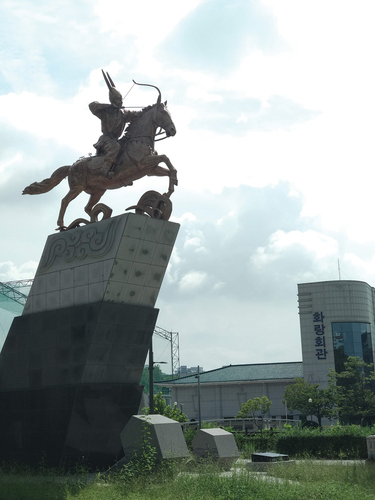
The symbolism of the horse in Seoul’s commemorative landscape extends beyond the narrative on the national level. In fact, four universities in Seoul and one in Suwon in the Seoul Capital Area have chosen the horse as their symbol and have erected horse statues on their campuses. Two of these universities are private Christian institutions and their statues depict a white horse, which is mentioned in the New Testament. At Myongji University the horse symbolizes loyalty, courage, obedience (to God), and holiness. As the school website explains, it is also connected to the horse-riding culture and history of the Korean people (Myŏngji University Citationn.d.). Soongsil University, the second Christian university, was originally founded in Pyongyang, which is now the capital city of North Korea and was once the area occupied by the ancient Koguryŏ. Accordingly, the university’s website states that it inherited the spirit of the horse-riding people of Koguryŏ (Sungsil University, Citationn.d.). The other two universities in Seoul, Korea National Sport University and Kwangwoon University, have erected statues of mythical horses. Lastly, Ajou University in Suwon has built a statue of a horse rider which, according to the school’s website, represents vision and leadership inspired by the spirit of the ancestors who expanded the ancient territories (Aju University Citationn.d.). Universities have thus utilized the horse to brand themselves and to promote a sense of pride and fellowship in their students and staff.
In conclusion, the statues of mounted masculine historical warriors in Seoul and throughout the country strengthen the connection between post-colonial South Korea and pre-division Korea, while they celebrate bravery and sacrifice. In the capital city these statues form the nationalist aspect of the current collaged cultural landscape of the horse. Most importantly, they are the aggregation of cultural heritage policies across time that aim to promote a narrative of national pride and belonging. This strategy that was initially institutionalized and advanced at the national level under Park Chung-hee’s dictatorship in the 1970s, has become more locally-focused since the early 2000s. In other words, while such statues were originally built under the broad context of a directive from the authoritarian government, they have been later erected on different occasions through specific local initiatives, as we saw in the cases of the second Kang statue and the hwarang statues. The city’s equestrian statues thus serve as devices to advance sentiments of patriotism, pride, and belonging. In doing so, they contribute to the official effort of securing loyalty, comradeship, and commitment. Importantly, as these statues make the horse a protagonist in the commemorative landscape and visually integrate the animal into South Korea’s national history, they further increase the significance of the horse’s collaged cultural landscape. On another level, statues of horses on campuses aim to contribute to the unique identity desired by each institution. The next section explores a district in Seoul that has also chosen the horse as an icon to represent and brand its identity.
Nowǒn: the horse-themed district
Nowŏn District is Seoul’s most northeastern ward (see in ). With a population of just over half a million, it ranks as the fourth most populous out of the city’s 25 districts. It is home to a notable concentration of academic institutions – including the aforementioned Kwangwoon University – as well as the Military Academy for training officers, which is under the direct control of the Army Headquarters. The district’s name, which dates back centuries, is said to have originated from the landscape of reeds that characterized the area, therefore it consists of the Chinese characters for ‘reed’ and ‘field’ (Kwŏn Citation2007). Importantly, it was a key spot on the transportation network of the Koryŏ and Chosŏn dynasties, and a horse station was established there. It is also argued that the sight of horses inspired the unofficial place name of ‘Madŭl Plain’ – a Korean expression that includes the word ‘ma’ which refers to horse (Kwŏn Citation2007).
Considering this historical background, the horse has gradually become a prominent feature in the district’s cultural landscape. In 1983 Kwangwoon University adopted the horse as its symbol, and in the 1990s several horse statues were built at various locations throughout the district. One notable sculpture is that of a rider on a leaping horse, which stands in front of the district’s office building (). Importantly, a significant trend in this regard has been noticeable since the mid-2000s. In 2008 the District completed a major renovation project with the aim of transforming the central and bustling, yet chaotic and messy, area around Nowŏn subway station into a much more attractive hub (Kwak Citation2008). Accordingly, Culture Street (Munhwa ŭi Kŏri) was established. At its entrance the ‘Arc de Triomphe’ of P’abalma was installed, which measures 6.4 meters in height and 10.45 meters in width. ‘P’abalma’ refers to the horse-reliant transportation system that was established during the Chosŏn dynasty for the delivery of important documents and information. Illustrations of horses decorate the arc’s pillars (), and a horse sculpture is one of Culture Street’s conspicuous decorative elements ().
Figure 8. Equestrian statue in front of Nowŏn District office building (Photograph by Author, 2023).
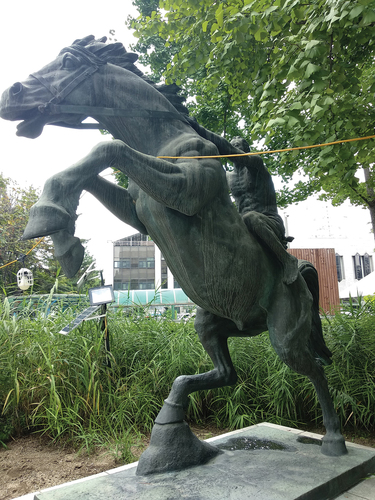
Figure 9. Horse decorations on ‘P’abalma Arc de Triomphe’, Culture Street, Nowŏn District (Photograph by Author, 2023).
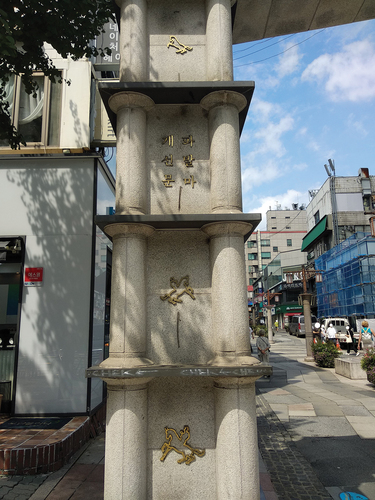
Into the 2010s, the trend of branding the district through the horse continued. In 2012 the District Council officially designated reeds as the plant symbol and the horse as the animal symbol of the district. In 2016 the aforementioned equestrian hwarang statues were erected at and in front of the Military Academy, thus adding a meaningful locally-contexed nationalist sentiment to the horse-related cultural landscape that was forming. Additionally, at that time an equestrian statue called ‘Pioneer’ or ‘Trailblazer’ (‘Sŏn’gusa’), which was erected in 1992, was moved and placed at the small plaza near exit 8 of Nowŏn subway station. A decorative ‘I Love Nowon’ sculpture is adjacent to this statue (). Furthermore, the horse has been incorporated into a larger context in two different locations. First, in 2015 the District opened ‘History Road’ (‘Yŏksa ŭi kil’) at the expansive Madŭl Neighborhood Park (Madŭl Kŭllnnin Kongwŏn), which features recreational areas, walking trails, sport facilities, and playgrounds. The history trail, spanning 560 meters, covers Korean and world history from prehistoric times to the modern era through models, sculptures, and explanatory signs. As the park’s grounds are adorned with several decorative horse statues, the animal is integrated into the park’s multifaceted purpose. Second, in 2017 the District also started to promote a recreational and educational project called Hwarangdae Railway Park (Hwarangdae Ch’ŏldo Kongwŏn). Situated near the Military Academy, the place has undergone remodeling and the addition of various attractions between 2018 and 2021. These include an exhibition hall, passenger cars and locomotive engines, a train café, a time museum, miniature railroad museum, and a gallery with exhibition spaces. In 2019 Seoul’s first night-light garden opened there, featuring various sculptures, including of horses and a flying unicorn ( and ). Reportedly, by late 2023 an estimated 770,000 people have visited the night-light garden, and the park as a whole has received acclaim from the Ministry of Culture, Sports, and Tourism (Shin Citation2023).
The impetus for Nowŏn District to significantly invest in branding during the first two decades of the 21st century can be explained by the context of the policies Seoul mayors were implementing at the time. In the 2000s, Mayors Lee Myung-bak (in office, 2002–2006) and Oh Se-hoon (2006–2011) were driven by a vision to strengthen Seoul’s global competitiveness, especially through large-scale redevelopment projects (H. Lee Citation2015; Nam and Lee Citation2023). In this context, under Oh, Seoul Government paid much attention to cultural policies aimed at upgrading the city’s image. This included creating slogans, characters, and icons, as well as hosting design-centered events and promoting ambitious projects like the huge multi-cultural Dongdaemun Design Plaza designed by renowned Iraqi-British architect Zaha Hadid. The goal was to establish a positive global image of Seoul through design (H. Lee Citation2015). As scholars have argued (H. Lee Citation2015; Nam and Lee Citation2023), a major problem with these policies was that they often marginalized citizens, leading to a significant display of dissatisfaction from the city’s residents. Oh’s successor, Mayor Park Won-soon (in office, 2011–2020), had a different perspective. Presenting himself as the ‘people’s mayor’, Park reduced large-scale, centrally-controlled cultural initiatives, and shifted cultural policies to a more local, citizen-focused level (H. Lee Citation2015).
Arguably, Seoul’s different districts which were already inspired to invest in branding themselves as part of Oh’s global vision, were driven to invest even more so under Mayor Park. Among others, in 2008 Seoul Government led by Mayor Oh created a character named ‘Haechi’ as the city’s symbol. In the 2010s, during Mayor Park’s term, there was wave of branding efforts that involved creating or revitalizing symbols and characters and engaging in related initiatives in various districts such as Dongdaemun, Dongjak, Gwanak, Jongno, Mapo, and Seodaemun, to mention a few examples.Footnote3 In this context of inter-city competitiveness, Nowŏn District also has allocated resources to brand itself, accentuating the district’s uniqueness through the horse. It had taken a meaningful step by establishing Culture Street during Mayor Oh’s tenure, and pursued with the various aforementioned initiatives that were advanced under Mayor Park’s administration. This cultural strategy has merged images of beauty, cuteness, vigor, and progression with nationalist notions of heroism and pride. By this, it has had a profound impact on the formation and the features of the horse’s collaged cultural landscape of Seoul.
Conclusion
The horse holds a special place in Korean history and culture, and this study explored several distinct manifestations of the animal in Seoul’s landscape. It should be noted that not all of these manifestation were discussed here. For example, worthy of mention are also the series of sculptures depicting mounted jockeys at Seoul Forest in Seongdong District – a highly popular attraction that opened in 2005 and is located on the former Ttuksŏm racecourse – and, a decorative equestrian statue on Jongno, one of Seoul’s busiest roads (). Thus, Seoul is dotted with various appearances of the horse: live racing horses, horses for leisure and therapeutic riding, equestrian statues of different styles, horse models and artefacts in museums, and ornamental and symbolic horse sculptures. The concept of the collaged cultural landscape is useful in identifying this phenomenon and providing a conceptual framework for understanding it.
The idea of the collaged cultural landscape invites us to examine the different cultural policies behind the materialization of a specific object, figure, or practice across space. Thus, various cultural policies have accumulated over time and in different contexts, each leaving its imprint and contributing to the material manifestation of the horse as a current collaged cultural landscape of Seoul. The dominant nationalist narrative of the cultural heritage policies, which impacted the horse’s symbolism during the dictatorship, has been replaced by more complex post-authoritarian strategies and images. Accordingly, the horse as a collaged cultural landscape in Seoul is a result and reflection of core concerns and desires of the city in particular and of South Korea in general. While becoming an element of the city’s identity, the horse has come to represent South Korean aspirations for economic success, positive branding/reputation, and post-colonial strength, confidence, and legitimacy by conveying a wide range of images, including beauty, cuteness, vigor, and valor. In terms of accessibility, it is possible to see and touch the animal as well as to occasionally encounter its symbolic and decorative cultural manifestations throughout the city. In terms of imagery and symbolism, the collaged cultural landscape of the horse in Seoul is multilayered.
In the final analysis, there is no other animal in Seoul, and perhaps in all of South Korea, that matches the horse’s complex presence. This argument has two interconnected important implications. First, it can be a departure point for future investigation aimed at revealing the bigger picture of animals as a cultural landscape in South Korea. Second, it draws attention to the possibilities that open up when the framework of the collaged cultural landscape is introduced into the study of human-nonhuman relations. By exploring the multiple representations of a specific animal across the space of a specific social, political, or ethnic entity, the concept shines a spotlight on the place of said animal in shaping the landscape and on the interests, politics, and policies behind it. In short, it is useful in revealing the intricacies of utilizing an animal as a meaningful material cultural symbol.
Disclosure statement
No potential conflict of interest was reported by the author(s).
Additional information
Notes on contributors
Guy Podoler
Guy Podoler is Senior Lecturer of Korean Studies at the Department of Asian Studies of the University of Haifa. His research interests include sports heritage, memory and commemoration, sports nationalism, and cultural diplomacy. His publications appeared in journals such as Acta Koreana, Asian Studies Review, International Journal of Cultural Policy, International Journal of the History of Sport, Sport in Society, and International Journal of Heritage Studies, and he contributed papers to edited volumes. His book is titled Monuments, Memory, and Identity: Constructing the Colonial Past in South Korea (Peter Lang AG, 2011). Podoler is senior book review editor for Asian Journal of Sport History and Culture.
Notes
1. The McCune-Reischauer Romanization system for Korean is employed in this paper. Exceptions are made when names of places and people are better known by a different spelling. For the readers’ convenience, exceptions are also made for the names of Seoul’s districts to align with the Romanization used in .
2. In 1910 Korea fell under Japanese colonial rule, which lasted until 1945. In 1948 the two separate states of South Korea, backed by the US, and North Korea, backed by the USSR, were founded. As noted, the horse also holds a special place in North Korean society, but this discussion is beyond the scope of the present paper.
3. For reports on the initiatives of the governments and councils of these districts see Tongjak Sinmun (Citation2013), Kim (Citation2011), Kim (Citation2020), Park (Citation2012), Sŏul Maeil (Citation2012), and TV Sŏul (Citation2017).
References
- Aju University. n.d. “Sangjingmul.” Accessed December 17, 2023. https://www.ajou.ac.kr/kr/intro/symbol01.do.
- Assmann, J. 1995. “Collective Memory and Cultural Identity.” New German Critique 65 :125–133. https://doi.org/10.2307/488538.
- Birke, L., and K. Brandt. 2009. “Mutual Corporeality: Gender and Human/HorseRelationships.” Women’s Studies International Forum 32 (3): 189–197. https://doi.org/10.1016/j.wsif.2009.05.015.
- Chŏn, C.-H. 2012. “Pak Chŏng-hŭi chŏnggwŏn ŭi Hoguk yŏngung mandŭlgi wa chŏnt’ong munhwa yusan chŏngch’aek.” Yŏksa Pip’yŏng 5:113–140.
- Chŏng, H.-K. 2007. “Pak Chŏng-hŭi sidae ŭi tongsang kŏllnnip undong kwa Aegukju ŭi Aeguk Sŏnyŏ Chosang Kŏllnnip Wiwŏnhhoe ŭi hwaldongŭl chungsimŭro.” Chŏngsin Munhwa Yŏn’gu 30 (1): 335–363.
- Chung, Y. S. S. 2005. “Seoul, Korea: Its Concept of Culture and Nature in Heritage Planning.” International Journal of Heritage Studies 11 (2): 95–111. https://doi.org/10.1080/13527250500070287.
- Coulter, K. 2014. “Herds and Hierarchies: Class, Nature, and the Social Construction of Horses in Equestrian Cultures.” Society & Animals 22 (2): 135–152. https://doi.org/10.1163/15685306-12341253.
- Cuneo, P. F. 2012. “Visual Aids: Equestrian Iconography and the Training of Horse, Rider and Reader.” In The Horse As Cultural Icon, edited by P. Edwards, K. A. E. Enenkel, and E. Graham, 71–97. Leiden, Boston: Brill.
- Dugnoille, J. 2018. “To Eat or Not to Eat Companion Dogs: Symbolic Value of Dog Meat and Human-Dog Companionship in Contemporary South Korea.” Food, Culture and Society 21 (2): 214–232. https://doi.org/10.1080/15528014.2018.1429075.
- Editor. 2018. “How Did Jeju Become an Island of Horses?” Jeju Weekly. September 24, 2018. http://www.jejuweekly.net/news/articleView.html?idxno=5973.
- Guibernau, M. 2004. “Anthony D. Smith on Nations and National Identity: A Critical Assessment.” Nations and Nationalism 10 (1–2): 125–141. https://doi.org/10.1111/j.1354-5078.2004.00159.x.
- Ha, N.-G., and J. A. Mangan. 1998. “The Knights of Korea: The Hwarangdo, Militarism and Nationalism.” The International Journal of the History of Sport 15 (2): 77–102. https://doi.org/10.1080/09523369808714029.
- Han, S.-Y., and K.-J. Cho. 2010. “Sŏulsi tosigongwŏn ŭi changsojŏk chaehyŏn: Kinyŏmsŏng, sangjingsŏng, changso kiŏgŭl chungsimŭro.” Han’guk Chogyŏnghak Hoeji 38 (2): 37–52.
- Hausberger, M., H. Roche, S. Henry, and E. K. Visser. 2008. “A Review of the Human–Horse Relationship.” Applied Animal Behaviour Science 109 (1): 1–24. https://doi.org/10.1016/j.applanim.2007.04.015.
- Hobson, K. 2007. “Political Animals? On Animals as Subjects in an Enlarged Political Geography.” Political Geography 26 (3): 250–267. https://doi.org/10.1016/j.polgeo.2006.10.010.
- Jager, S. M. 2002. “Monumental Histories: Manliness, the Military, and the War Memorial.” Public Culture 14 (2): 387–409. https://doi.org/10.1215/08992363-14-2-387.
- Jang, J., and K. Kim. 2023. “A Comparative Study of the Military Tactics of the Mongol Empire and Goguryeo Kingdom (Goryeo) Mongolian Diaspora.” Journal of Mongolian History and Culture 3 (1): 53–68. https://doi.org/10.1515/modi-2023-2001.
- Jeon, C., and Y. Kang. 2019. “Restoring and Re-Restoring the Cheonggyecheon: Nature, Technology, and History in Seoul, South Korea.” Environmental History 24 (4): 736–765. https://doi.org/10.1093/envhis/emz032.
- Kallander, G. 2023. Human-Animal Relations and the Hunt in Korea and Northeast Asia. Edinburgh: Edinburgh University Press.
- Kang, H. 2022. “Jeju Horses, Native of Tamna Kingdom.” Korea Herald. April 16, 2022. https://www.koreaherald.com/view.php?ud=20220414000615.
- Kang, P.-C. 2023. “Ogammanjok hilling sŭp’at ŏdi? Retch’ŭrŏn P’ak’ŭ Sŏul, naman algo sip’ŭn changso.” Chosŏn Ilbo. May 18, 2023. https://www.chosun.com/sports/sports_general/2023/05/18/DKMRGIHCFSJ62WOX5AFKHCENJQ/.
- Kang, S. H., and G.-S. Park. 2016. “Overcoming Ethical Issues Through Symbolic Management, Cultivating Proponents and Storytelling: The Institutionalization of Korea’s Horseracing Industry.” Asia Pacific Business Review 22 (3): 439–451. https://doi.org/10.1080/13602381.2015.1129772.
- Kang, S.-P. 2022. “Kaŭl ch’ukje ŭi p’inalle nŭn Retch’ŭrŏn P’ak’ŭ Sŏulesŏ.” Sŭp’och’ŭ Kyŏnghyang. October 20, 2022. https://sports.khan.co.kr/bizlife/sk_index.html?art_id=202210200903003&sec_id=561501.
- KBS World. 2023. “Horseback Riding in N. Korea.” September 27, 2023. https://world.kbs.co.kr/service/contents_view.htm?lang=e&board_seq=444576.
- Kim, C.-H. 2020. “2hosŏn Naksŏngdae Yŏk, Kang Kam-ch’an Yŏk pyŏnggi choejong hwakjŏng.” Kwanak Chŏnŏl. February 10, 2020. http://xn–zb0b20fnzw5rc.kr/13970.
- Kim, H., R. Clements, and M. Rhyu. 2023. “A Genealogy of Tiger Nationalism in Korea: Post-Colonial Discourse, Ch’oe Namsŏn and the Seoul Olympics.” International Journal of Asian Studies 20 (2): 555–574. https://doi.org/10.1017/S1479591421000668.
- Kim, J.-M. 2017. “A Korean Horse-Story.” Korea Times. January 13, 2017. https://www.koreatimes.co.kr/www/opinion/2023/11/638_222025.html.
- Kim, J.-Y. 2015. “The Horse Industry in Korea: Its Present Condition and Prospect.” Advanced Science and Technology Letters 99:256–260.
- Kim, M.-C. 2011. “[Sŏdaemun-gu] Hwijang pyŏn’gyŏng, tongnip chŏngsin, hwahap, paljŏn sangjing.” Sŏul T’aimsŭ. April 25, 2011. http://www.seoultimes.net/news/articleView.html?idxno=8322.
- Kim, M.-J. 2016. “Koryŏ T’aejo wanggŏn ŭi kibyŏng unyŏng e taehan kŏmt’o.” Kunsa 101:397–427.
- Kim, S.-E. T. 2016. “Perception of Monastic Slaves by Scholar-Officials and Monks in the Late Koryŏ and Early Chosŏn Periods.” Journal of Korean Religions 7 (1): 5–34. https://doi.org/10.1353/jkr.2016.0007.
- Kim, W.-H., K.-D. Min, S.-I. Cho, and S. Cho. 2020. “The Relationship Between Dog-Related Factors and Owners’ Attitudes towards Pets: An Exploratory Cross-Sectional Study in Korea.” Frontiers in Veterinary Science 7:493. https://doi.org/10.3389/fvets.2020.00493.
- KRA. n.d.-a. “Ch’uch’ŏn k’osŭ.” Accessed December 8, 2023. https://park.kra.co.kr/parkuserseoul/infoParkSuggestFamily.do.
- KRA. n.d.-b. “History of Korean Horse Racing.” Accessed November 30, 2023. https://www.kra.co.kr/globalEn/historyofKoreanHorseracing.do.
- KRA. n.d.-c. “Horse Culture of Korea.” Accessed May 4, 2023. https://www.kra.co.kr/globalEn/horseCultureofKorea.do.
- KRA. n.d.-d. “Key Facts.” Accessed November 30, 2023. https://www.kra.co.kr/globalEn/keyFactor.do.
- KRA. n.d.-e. “Pangmulgwan sogae.” Accessed December 6, 2023. https://park.kra.co.kr/informationMuseumInformation.do?type=0.
- Kwachŏn City. n.d. “Natural Symbols.” Accessed December 1, 2023. https://www.gccity.go.kr/english/contents.do?mId=0103000000.
- Kwak, S.-K. 2008. “Ije Nowŏnyŏk kŏrien si wa kŭrim kwa ŭmagi itta.” Chosŏn Ilbo. October 7, 2008. https://www.chosun.com/site/data/html_dir/2008/10/06/2008100601618.html.
- Kwŏn, S.-H. 2007. “Nowŏn ŭi yurae.” Accessed December 23, 2023. https://www.dojung.net/bbs/board.php?bo_table=comm_02&wr_id=6085.
- Lee, H. 2015. “Branding the Design City: Cultural Policy and Creative Events in Seoul.” International Journal of Cultural Policy 21 (1): 1–19. https://doi.org/10.1080/10286632.2014.890604.
- Lee, K. 2022. “We Will Make Korea a World-Class Horse Racing Country.” The Korea Post. May 20, 2022. https://www.koreapost.com/news/articleView.html?idxno=28360.
- Lee, M.-J. 2019. “Transforming Post-Industrial Landscapes into Urban Parks: Design Strategies and Theory in Seoul, 1998-Present.” Habitat International 91:1–13. https://doi.org/10.1016/j.habitatint.2019.102023.
- Lee, S.-H. 2013. “Jeju Island and Horses.” Korea Times. August 29, 2013. https://www.koreatimes.co.kr/www/opinion/2023/10/137_141944.html.
- Lee, S.-W. 2017. “Sop’ung kwa teit’ŭ changsorodo sonsaekŏmnŭn Retch’ŭrŏn P’ak’ŭ Sŏul ch’ehŏmgi.” Taehan Min’guk Ku Sŏkkusŏk. April 12, 2017. https://korean.visitkorea.or.kr/detail/rem_detail.do?cotid=bd7ea812-f9d5-43eb-8d8d-9e23ae065ab3.
- Li, Z. 2019. A Survey on Horse Use and Management in Horse Clubs in China: A Pilot Study.” PhD diss., Murray State University.
- Morgan, D. 2022. “Korea’s Big Day Returns and Puts Overseas Travel Back on the Agenda.” Asian Racing Report. September 7, 2022. https://asianracingreport.com/koreas-big-day-returns-and-puts-overseas-travel-back-on-the-agenda/.
- Museum News. 2020. “[Kungnip Kimhae Pangmulgwan] Tŭkpyŏljŏn ‘Marŭl t’an Kaya’.” Museum News. November 17, 2020. https://museumnews.kr/271ex01/?ckattempt=1.
- Myadar, O. 2011. “Imaginary Nomads: Deconstructing the Representation of Mongolia as a Land of Nomads.” Inner Asia 13 (2): 335–362.
- Myŏngji University. n.d. “Sangjing tongmul.” Accessed December 17, 2023. https://www.mju.ac.kr/mjukr/166/subview.do#language.
- Nam, S., and S.-O. Lee. 2023. “Urban Regeneration in Seoul: Alternative Urbanism or the Resilience of Neoliberal Urbanism?” International Journal of Urban and Regional Research 47 (4): 601–623. https://doi.org/10.1111/1468-2427.13180.
- National Folk Museum of Korea. n.d. “Horse.” Accessed May 4, 2023. https://www.nfm.go.kr/english/subIndex/1018.do.
- National Museum of Korea. 2019. “Silla Horse-rider-shaped Vessels.” February 22, 2019. https://www.museum.go.kr/site/eng/archive/united/14946.
- Ok, G., S. Choi, and H. S. Jeong. 2010. “’The Disturbance of War’: The Ancient Origin and Development of Korean Archery.” The International Journal of the History of Sport 27 (3): 523–536. https://doi.org/10.1080/09523360903556824.
- Park, C.-Y. 2022. “Han’guk kyŏngma 100 nyŏn … saeroun 100 nyŏn ŭl kkumkkuda.” Kyŏngnam Sinmun. June 9, 2022. https://www.knnews.co.kr/news/articleView.php?idxno=1378493.
- Park, P.-M. 2012. “’Noksaek hyanggi p’um ŭn Chongno-gu’ … Chongno-gu ŭi ŭimiittnŭn pyŏnsin sijaktoeda.” Ilgan Chŏnbuk. November 27, 2012. http://www.jbkns.com/news/articleView.html?idxno=58503.
- Sanders, C. R. 2003. “Actions Speak Louder Than Words: Close Relationships Between Humans and Nonhuman Animals.” Symbolic Interaction 26 (3): 405–426. https://doi.org/10.1525/si.2003.26.3.405.
- Seeley, J., and A. Skabelund. 2015. “Tigers – Real and Imagined – in Korea’s Physical and Cultural Landscape.” Environmental history 20 (3): 475–503.
- Seoul Metropolitan Government. 2023. “Seoul’s Roadmap to Expand the City’s Urban Green Spaces.” June 2, 2023. https://english.seoul.go.kr/seouls-roadmap-to-expand-the-citys-urban-green-spaces/.
- Shahar, M. 2019. “The Chinese Cult of the Horse King, Divine Protector of Equines.” In Animals and Historical Human Society in Asia: Historical, Cultural and Ethical Perspectives, edited by R. Kowner, G. Bar-Oz, M. Biran, M. Shahar, and G. Shelach-Lavi, 355–390. Cham, Switzerland: Palgrave Macmillan.
- Shin, I.-Y. 2023. “Nowŏn-gu, Hwarangdae Ch’ŏldo Kongwŏn (Nowŏn Pulbit Chŏngwŏn) ilnaetta.” Sijŏng Ilbo. October 23, 2023. http://www.sijung.co.kr/news/articleView.html?idxno=302827.
- Sintionean, C. 2014. “Heritage Practices during the Park Chung Hee Era.” In Key Papers on Korea: Essays Celebrating 25 Years of the Centre of Korean Studies, SOAS, University of London, edited by A. D. Jackson, 253–274. Leiden: Global Oriental.
- Smith, L. 2006. Uses of Heritage. London: Routledge.
- Sŏul Maeil. 2012. “Tongdaemun-gu sangjing ‘Kkumdongi’ t’ansaeng.” Sŏul Maeil. September 24, 2012. http://www.smaeil.com/news/articleView.html?idxno=99078.
- Statista. 2023. “Number of People Riding Horses Regularly in South Korea from 2016 to 2022.” Accessed November 30, 2023. https://www.statista.com/statistics/1347394/south-korea-number-of-people-riding-horses-regularly/#:~:text=In%202022%2C%20around%2058.7%20thousand,member%20of%20horse%20riding%20clubs.
- Stewart, P. 2012. “The Equestrian Statue of Marcus Aurelius.” In A Companion to Marcus Aurelius, edited by M. Van Ackeren, 264–277. Chichester, UK: Wiley-Blackwell.
- Sungsil University. n.d. “Sangjing. Paekma.” Accessed December 17, 2023. https://ssu.ac.kr/%ED%95%99%EA%B5%90%EC%86%8C%EA%B0%9C/%ED%95%99%EA%B5%90%EC%83%81%EC%A7%95/%EC%83%81%EC%A7%95/#1556521788651-a6c5c790-7cbfe9f6-e29f.
- Swope, K. 2005. “Crouching Tigers, Secret Weapons: Military Technology Employed During the Sino-Japanese-Korean War, 1592–1598.” The Journal of Military History 69 (1): 11–41. https://doi.org/10.1353/jmh.2005.0059.
- Taylor, K. 2012. “Landscape and Meaning: Context for a Global Discourse on Cultural Landscapes Values.” In Managing Cultural Landscapes, edited by K. Taylor and J. L. Lennon, 21–44. Abingdon, Oxon, and New York, NY: Routledge.
- TCLF (Cultural Landscapes Foundation). n.d. “About Cultural Landscapes.” Accessed November 22, 2023. https://www.tclf.org/places/about-cultural-landscapes.
- Tongjak Sinmun. 2013. “Tongjak-gu, kukka sangjing (t’aegŭkki) sŏnyang taet’ongnyŏng kigwan p’yŏch’ang.” Tongjak Sinmun. December 30, 2013. http://www.thedjnews.com/news/articleView.html?idxno=232.
- Tozaki, T., M. Kikuchi, H. Kakoi, K. Hirota, S. Nagata, D. Yamashita, T. Ohnuma, et al. 2019. “Genetic Diversity and Relationships among Native Japanese Horse Breeds, the Japanese Thoroughbred and Horses Outside of Japan Using Genome-Wide SNP DataTozaki.” Animal genetics 50 (5): 449–459.
- TV Sŏul. 2017. “Map’o-gu, sae pŭraendŭro saerŏpke tosi tijainhada.” TV Sŏul. January 13, 2017. http://www.tvseoul.kr/mobile/article.html?no=8806.
- UNESCO. n.d. “Cultural Landscapes.” Accessed November 22, 2023. https://whc.unesco.org/en/culturallandscape/#1.
- Zhang, R., and S. Brown. 2023. “Comparing Landscape Values and Heritage Stakeholders: A Case Study of West Lake Cultural Landscape of Hangzhou, China.” International Journal of Cultural Policy 29 (2): 184–201. https://doi.org/10.1080/10286632.2022.2038142.
- Zhang, R., and K. Taylor. 2020. “Cultural Landscape Meanings. The Case of West Lake, Hangzhou, China.” Landscape Research 45 (2): 164–178. https://doi.org/10.1080/01426397.2019.1589438.

